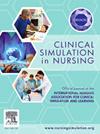虚拟现实嵌入式讲师:一次一创新地转变护理教育
IF 2.5
3区 医学
Q1 NURSING
引用次数: 0
摘要
护理教育中的虚拟现实模拟(VRS)通常促进教师参与有限的自主学习。本研究调查了在虚拟现实环境中嵌入临床讲师如何影响护理学习者的体验。方法采用一种新颖的虚拟现实仿真嵌入式讲师模型,对213名大三护理学生进行了为期两个学期的描述性定性研究。学习者参加了胸痛急诊科模拟,导师在场。数据收集采用经过验证的模拟有效性工具修正(SET-M)问卷和定性反馈。结果大多数学习者表示,VR模拟提高了他们的信心(76.6%),并为患者病情的变化做好了准备(90.7%)。经过预先简报修改后,2025年春季队列比2024年秋季队列表现出改善。定性反馈显示学习者重视教师的即时反馈、指导和批判性思维的提示。汇报会议对学习的贡献被高度评价(93.9%)。结论VRS嵌入式教师模型有效提高了学习者的自信心、备课能力和临床判断能力。尽管资源紧张,但在虚拟环境中嵌入教师提供了反映现实世界临床实践的基本指导,解决了传统VR在护理教育中实施的局限性。本文章由计算机程序翻译,如有差异,请以英文原文为准。
The virtual reality embedded instructor: Transforming nursing education one innovation at a time
Background
Virtual reality simulations (VRS) in nursing education typically promote independent learning with limited faculty involvement. This study investigated how embedding clinical instructors within VR environments influences nursing learners' experiences.
Methods
This descriptive qualitative study implemented a novel Virtual Reality Simulation Embedded Instructor Model with junior nursing students (n = 213) across two semesters. Learners participated in a chest pain emergency department simulation with instructors present virtually. Data collection utilized the validated Simulation Effectiveness Tool-Modified (SET-M) questionnaire and qualitative feedback.
Results
Most learners reported increased confidence (76.6%) and better preparation for patient condition changes (90.7%) following VR simulation. The spring 2025 cohort showed improvement over the Fall 2024 cohort after prebriefing modifications. Qualitative feedback revealed that learners valued instructor presence for immediate feedback, guidance, and critical thinking prompts. Debriefing sessions were highly rated (93.9%) for contributing to learning.
Conclusion
The VRS Embedded Instructor Model effectively enhanced learner confidence, preparedness, and clinical judgment. Despite resource intensity, embedding instructors in virtual environments provides essential guidance that mirrors real-world clinical practice, addressing limitations of traditional VR implementations in nursing education.
求助全文
通过发布文献求助,成功后即可免费获取论文全文。
去求助
来源期刊

Clinical Simulation in Nursing
NURSING-
CiteScore
5.50
自引率
15.40%
发文量
107
期刊介绍:
Clinical Simulation in Nursing is an international, peer reviewed journal published online monthly. Clinical Simulation in Nursing is the official journal of the International Nursing Association for Clinical Simulation & Learning (INACSL) and reflects its mission to advance the science of healthcare simulation.
We will review and accept articles from other health provider disciplines, if they are determined to be of interest to our readership. The journal accepts manuscripts meeting one or more of the following criteria:
Research articles and literature reviews (e.g. systematic, scoping, umbrella, integrative, etc.) about simulation
Innovative teaching/learning strategies using simulation
Articles updating guidelines, regulations, and legislative policies that impact simulation
Leadership for simulation
Simulation operations
Clinical and academic uses of simulation.
 求助内容:
求助内容: 应助结果提醒方式:
应助结果提醒方式:


